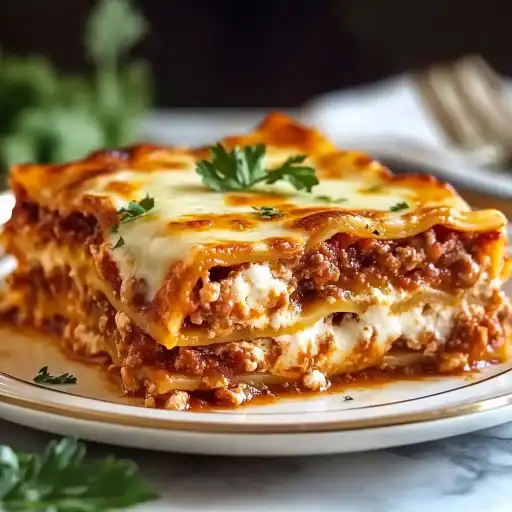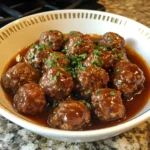Description of this recipe: Classic Italian Lasagna is a comforting and satisfying dish that layers rich meat sauce, creamy cheese, and perfectly cooked pasta. This lasagna recipe brings together the best of Italian flavors, creating a hearty and delicious meal that’s perfect for family dinners, gatherings, or any special occasion. Each bite is a symphony of textures and tastes, from the savory meat sauce to the smooth ricotta and the melted mozzarella.
Why you will love this recipe: You will love this Classic Italian Lasagna because it’s a guaranteed crowd-pleaser that combines the best of Italian cuisine into one unforgettable dish. The rich, homemade meat sauce is simmered to perfection, infusing every layer with deep, savory flavors. The creamy ricotta cheese mixture adds a delightful lightness and tang, while the melted mozzarella cheese creates a gooey, golden-brown topping that’s simply irresistible. Whether you’re a seasoned cook or a beginner, this recipe is easy to follow and delivers consistently delicious results. Plus, making lasagna is a great way to bring family and friends together, creating lasting memories around the dinner table.
Ingredients:
For the Meat Sauce:
- 1 pound ground beef
- ½ pound Italian sausage – removed from casing
- 1 small onion – finely chopped
- 3 cloves garlic – minced
- 1 can (28 oz) crushed tomatoes
- 1 can (15 oz) tomato sauce
- 1 can (6 oz) tomato paste
- 1 teaspoon dried oregano
- 1 teaspoon dried basil
- ½ teaspoon salt
- ½ teaspoon black pepper
- 1 teaspoon sugar – optional, to balance acidity
For the Cheese Mixture:
- 1 container (15 oz) ricotta cheese
- 1 cup shredded Parmesan cheese
- 1 large egg
- 1 teaspoon dried parsley
For Assembling the Lasagna:
- 12 lasagna noodles – cooked al dente
- 2 cups shredded mozzarella cheese
- ½ cup Parmesan cheese – for topping
Preparation:
Step 1: Prepare the Meat Sauce: In a large skillet, heat over medium-high heat. Add the ground beef and Italian sausage, breaking them up as they cook. Ensure the meat is browned evenly to develop a rich, savory flavor. Once browned, drain any excess fat to prevent a greasy lasagna. Add the finely chopped onion and minced garlic to the skillet. Cook until the onion becomes translucent and the garlic is fragrant, usually about 3-5 minutes. This step infuses the sauce with aromatic flavors that are essential to the lasagna’s overall taste. Stir in the crushed tomatoes, tomato sauce, tomato paste, dried oregano, dried basil, salt, pepper, and sugar (if using). The sugar balances the acidity of the tomatoes, resulting in a smoother, more harmonious flavor. Let the sauce simmer for 20–30 minutes, stirring occasionally. Simmering allows the flavors to meld together, creating a deep, complex sauce that forms the heart of the lasagna.
Step 2: Cook the Noodles: Bring a large pot of salted water to a boil. The salt not only seasons the noodles but also helps prevent them from sticking together. Cook the lasagna noodles according to the package instructions until al dente. Al dente noodles have a slight bite to them, ensuring they hold their shape during baking and don’t become mushy. Drain the noodles thoroughly and set aside.
Step 3: Prepare the Cheese Mixture: In a mixing bowl, combine the ricotta cheese, shredded Parmesan cheese, one large egg, and dried parsley. Mix until the mixture is smooth and well combined. The ricotta cheese provides a creamy texture, the Parmesan cheese adds a nutty, savory flavor, the egg binds the mixture together, and the dried parsley provides a touch of freshness.
Step 4: Assemble the Lasagna: Preheat the oven to 375°F (190°C). Spread a thin layer of meat sauce on the bottom of a greased 9×13-inch baking dish. This prevents the noodles from sticking and adds a layer of flavor to the bottom of the lasagna. Arrange 3 lasagna noodles over the sauce, overlapping slightly if necessary. Spread a portion of the ricotta cheese mixture evenly over the noodles, then add another layer of meat sauce and sprinkle with shredded mozzarella cheese. Repeat the layering process two more times, finishing with a layer of noodles, the remaining meat sauce, and the remaining mozzarella cheese. Top with additional Parmesan cheese for a golden, bubbly crust.
Step 5: Bake: Cover the dish with aluminum foil to prevent the cheese from browning too quickly and to ensure the lasagna cooks evenly. Bake for 25 minutes. Remove the foil and bake for an additional 15 minutes, or until the cheese is bubbly, melted, and golden brown. The total baking time may vary depending on your oven, so keep an eye on the lasagna to prevent burning.
Step 6: Let It Rest and Serve: Allow the lasagna to rest for at least 10 minutes before slicing. This allows the lasagna to set, making it easier to cut and serve. Garnish with fresh basil or parsley if desired for added freshness and visual appeal. Serve hot and enjoy!
COOKING Rating: 5/5
Serving Suggestions: Classic Italian Lasagna is a complete meal on its own, but it pairs well with a variety of side dishes to create a balanced and satisfying meal. Consider serving it with a fresh garden salad, garlic bread, or steamed vegetables. A simple vinaigrette dressing complements the richness of the lasagna. For a more elegant touch, serve with a glass of red wine, such as Chianti or Cabernet Sauvignon.
Tips:
- For an even richer flavor, use a combination of ground beef and ground pork in the meat sauce.
- To save time, you can prepare the meat sauce and cheese mixture ahead of time and store them in the refrigerator until ready to assemble the lasagna.
- If you don’t have ricotta cheese, you can substitute it with cottage cheese or mascarpone cheese.
- For a vegetarian option, replace the meat sauce with a vegetable-based sauce or a layer of sautéed vegetables such as zucchini, eggplant, and bell peppers.
- To prevent the lasagna from sticking to the baking dish, grease the dish thoroughly or line it with parchment paper.
- If the cheese starts to brown too quickly during baking, cover the dish with aluminum foil.
Prep Time: 30 minutes Cook Time: 1 hour Total Time: 1 hour 30 minutes
Nutritional Information: (per serving) Calories: Approximately 450-550 Protein: 30-35g Sodium: 700-900mg
Conclusion: Classic Italian Lasagna is a timeless dish that brings comfort and joy to any occasion. With its rich flavors, creamy textures, and satisfying layers, this lasagna recipe is sure to become a family favorite. Whether you’re making it for a special celebration or a cozy weeknight dinner, the process of creating and sharing this delicious dish is a rewarding experience. Enjoy the compliments and the satisfaction of knowing you’ve created a truly memorable meal.
5 Questions and Answers about this recipe:
Question 1: Can I make this lasagna ahead of time? Answer: Yes, you can absolutely make this lasagna ahead of time! In fact, it often tastes even better the next day after the flavors have had a chance to meld together. Assemble the lasagna as instructed, cover it tightly with plastic wrap and then aluminum foil, and store it in the refrigerator for up to 24 hours. When you’re ready to bake it, let it sit at room temperature for about 30 minutes before placing it in the oven. Bake as directed, adding a few extra minutes if needed to ensure it’s heated through.
Question 2: Can I freeze this lasagna? Answer: Yes, you can freeze this lasagna for longer storage. Assemble the lasagna in a freezer-safe dish, cover it tightly with plastic wrap, and then wrap it again with aluminum foil. Freeze for up to 2-3 months. When you’re ready to bake it, you can bake it directly from frozen, but you’ll need to add extra baking time – about 30-45 minutes – to ensure it’s heated through. Alternatively, you can thaw it in the refrigerator overnight before baking as directed.
Question 3: What can I use instead of ricotta cheese? Answer: If you don’t have ricotta cheese on hand, you can substitute it with cottage cheese or mascarpone cheese. Cottage cheese will provide a similar texture, but it may have a slightly tangier flavor. Mascarpone cheese is richer and creamier than ricotta, so it will add a luxurious touch to the lasagna. Just be sure to drain any excess liquid from the cottage cheese before using it to prevent a watery lasagna.
Question 4: Can I add vegetables to this lasagna? Answer: Absolutely! Adding vegetables is a great way to customize the lasagna and add extra nutrients. Sautéed vegetables like zucchini, eggplant, bell peppers, spinach, or mushrooms work well in lasagna. Simply sauté the vegetables until they’re tender, then layer them in the lasagna along with the meat sauce and cheese mixture.
Question 5: How can I prevent my lasagna from being watery? Answer: To prevent your lasagna from being watery, there are a few things you can do. First, make sure to drain any excess fat from the meat after browning it. Second, drain any excess liquid from the ricotta cheese before using it. Third, don’t overcook the noodles, as they will release starch and moisture during baking. Finally, let the lasagna rest for at least 10 minutes before slicing it, as this allows the sauce to thicken and set.




